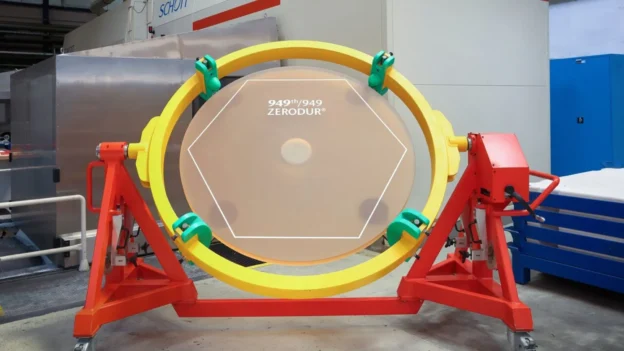The European Southern Observatory ‘s (ESO) World’s Largest Telescope (ELT), currently under construction in the Atacama Desert in Chile, has reached a significant breakthrough with the delivery of the last raw segment of its primary mirror. The German company SCHOTT has successfully completed the shipment of this crucial part, marking a decisive step towards completion of the telescope.
With a diameter of more than 39 meters, the ELT’s M1 mirror will become the largest ever made for a telescope.
Construction of the world’s largest telescope mirror completed
The construction of the M1 mirror was not an easy task due to its monumental size. Instead of being a single piece of glass, the mirror is composed of 798 hexagonal segments, each approximately five centimeters thick and 1.5 meters in diameter. These segments work together to capture an amount of light much greater than the capacity of the human eye.
In addition, 133 additional segments have been produced for maintenance and coating, together with 18 spare segments, totaling 949 parts.

The progress of the construction of the Extremely Large Telescope. Source: ESO.
It is important to mention that the mirror segments, known as M1 blanks, are material molds that are subsequently polished to form the final mirror segments. They are made of ZERODUR®, a low expansion glass ceramic material developed by SCHOTT, specially adapted to the extreme temperature conditions of the Atacama Desert.
SCHOTT has also produced the blanks for the other three ELT mirrors (M2, M3 and M4) at its facility in Mainz, Germany.
Cayrel praises SCHOTT
Marc Cayrel, Director of Optomechanics at ESO’s ELT, expressed his satisfaction with SCHOTT’s work, highlighting the close collaboration and the high quality of the final product. Thomas Werner, ELT project leader at SCHOTT, emphasized that this project has been ZERODUR’s largest order in the company’s history.in the company’s history, underlining the honor and responsibility of participating in a project of such magnitude.
The production process of the mirror segments involves a complex international journey. After controlled cooling and heat treatment, the surface of each blank is precisely shaped at SCHOTT’s facilities. The parts are then sent to the French company Safran Reosc, where they are cut into hexagonal shapes and polished to nanometer precision. This ensures that irregularities on the mirror surface are less than one thousandth the width of a human hair.
ELT telescope assembly process
Several companies have contributed to the assembly of the M1 segments. The Dutch company VDL ETG Projects BV produces the segment supports, while the Franco-German consortium FAMES develops the precision sensors. The German company Physik Instrumente manufactures the actuators that position the segments and the Danish company DSV is responsible for transporting the segments to Chile.
Each polished and assembled segment is shipped to the ELT Technical Facility at ESO’s Paranal Observatory in the Atacama Desert, traveling 10,000 km. Once there, the segments are coated with a silver layer to make them reflective and stored until the main telescope structure is ready to receive them.
When it becomes operational later this decade, ESO’s Extremely Large Telescope will become the world’s largest telescope, ready to tackle the greatest astronomical challenges and make as yet unimaginable discoveries.
Follow us on social networks and don’t miss any of our publications!
YouTube LinkedIn Facebook Instagram X
Source and photo: elt.eso

